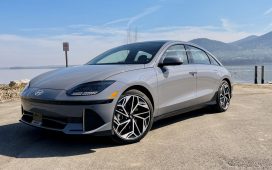Yes, that’s an e-bike, despite the hidden battery and motor that’s so quiet and diminutive that nobody would expect it. It’s built by Ampler, which isn’t a household name — but should be.
Founded in 2014, the Estonia-based company was one of the first to recognize that sleekly designed e-bikes are an ideal form of clean and convenient urban transport for young commuters at a time when bicycles with ugly bolt-on batteries were still the domain of cycling septuagenarians. Now, Ampler is back with five models of e-bikes injected with all the know-how the company has accumulated since.
I’ve been testing Ampler’s Yoda-green Axel in Amsterdam, where the company recently opened a showroom and service center, its fifth in Europe. I actually started this review a year ago, but a series of issues, both in and out of Ampler’s control, created quite a few issues and delays that I’ll go into later.
The Axel e-bike isn’t as aggressively styled as Ampler’s Curt or as relaxed as the Juna or Stellar models. Nor is it as sturdy as the company’s Stout. For me, Axel sits right at the sweet spot of sporty yet practical. It’s for anyone looking to travel long distances on a well-made commuter bike that’s also great for running errands around town — so long as you live in Europe and can afford its €2,790 (about $2,970) price tag.
But hey, shipping is free.
Wait, that’s an electric bike?
Refreshingly, Ampler is an e-bike company, not an e-bike plus services company that tries to tempt you with costly upsells like European rivals VanMoof and Cowboy. Ampler also uses lots of industry-standard parts that your local bike shop can procure and service, assuming the supply chain hasn’t been upended, as it has been for much of the last three years.
The first thing you notice about the Axel is that it looks like an ordinary bike. That’s because Ampler integrates the battery into the downtube as it does on every model the company sells. The tiny 250W motor (400W peak) of custom Ampler design is located in the hub of the rear wheel. The result is a great-looking e-bike, though one drawback is a non-removable battery (it comes out only for service), which could complicate charging for many city dwellers. Fortunately, though, should you need to maneuver it inside a building or hoist it up and down some stairs, the Axel is relatively light at 16.3kg (almost 36 pounds).
Axel comes in two sizes to fit riders from 172 to 200cm (5ft 8in to 6ft 7in). The rear carrier on my review bike is a €60 option (about $64), but the excellent front and rear lights, fenders, and kickstand all come standard. Axel is currently only available in this matte-green finish I rather enjoy.
Ampler has also done a better job hiding the cables on its second-generation e-bikes. Not only does that make this Axel e-bike look better — it prevents anything from getting snagged when trying to lock the bike in crowded parking stands.
Okay, but how does it ride?
Riding the Axel is comfortable and intuitive. The saddle felt good even after longer rides, and the grips offer an extra degree of sponginess needed to offset the hand-heavy forward stance. The single-speed Gates Carbon belt drive means no shifting and no maintenance of a messy chain and derailleur. And because Axel is fitted with a torque sensor, the pedal-assisted power is delivered in harmony with the pressure you exert on each downstroke.
Still, starting the single-speed bike on even a moderate slope can be a bit of a struggle for the bike’s rated 45Nm of max torque, even in the most powerful pedal-assist mode. If that concerns you, then maybe consider the 11-speed Ampler Curt or nine-speed Stout and Stellar models. The Axel’s motor does a better job at leveling out those hills as they arrive during the commute, however. The throttle-less e-bike offers two pedal-assisted riding modes, which can be toggled in the app or by tapping the button located beneath the on-bike display. It shows the basics, like charge level and trip statistics. The button can also be used to turn the bike on and of, as well as the lights, without having to resort to the app.
The Axel’s relatively fat Continental Contact Urban 50-584 tires feel fantastic on a commuter bike. They soak up bumps reasonably well and make the bike feel stable, even while carrying heavy loads like groceries in bags slung from the grips, a Christmas tree laid across the length, or even a new friend perched precariously on the rear rack after a night out. They also survived a direct hit to chunks of shattered glass from a smashed bottle on the street during my testing — damn tourists.
I did all my testing in max power on mostly flat roads, allowing me to take the 48V 336Wh battery from 100 percent to empty in 54km (33.6 miles). A few other range tests petered out in the low 40km range, however. That’s mostly consistent with Ampler’s claim of 50km to 100km on a single charge. You can, of course, ride the Axel without any power at all if you run out of juice or just looking for the exercise. Otherwise, it will recharge in a little less than 2.5 hours using the included 3A charger.
Measuring speed on a Garmin watch, the motor usually stops providing assistance at around 27km/h, which Ampler says is within the 25km/h max speed tolerances allowed by the EU. Two-piston hydraulic brakes at the front and back bring the Axel to a stop with confidence and control, with the added benefit of the rear nighttime running light serving as a brake indicator.
The Ampler motor is essentially silent, easily masked by the din of the city and wind in my ears. Some early Axels I tested had a noisy freewheel, but my final review model sounded just right when coasting. Taken together with the styling, tiny motor, and fact that the display shuts off as soon as you get up to speed, nobody riding next to an Axel will know it’s an e-bike.
Ampler controls its own firmware and app development
Another way Ampler stands apart is with control over its own firmware and app development. The app connects to the bike over Bluetooth and opens to a customizable dashboard showing charge, speed, and range remaining. It can also be used to lock the motor, show the bike’s location, and monitor historical ride statistics. The app is also needed to send firmware updates to Ampler’s new bikes, allowing them to be serviced in the field, sometimes before owners even know there’s a problem. For me, the app strikes a good balance of being useful without trying to do too much, unlike many other e-bike apps out there.
Ampler’s locking feature is a bit underwhelming at the moment. Locking the Axel does two things. First, it prevents the pedal assist from being turned on until the motor is unlocked in the app — but the bike can still be pedaled away. Second, it causes the front and rear lights to silently flash if the bike is jostled.
The new location tracking works, but its precision can be hit-and-miss. Connectivity depends upon the availability of LTE-M and 2G services in the area, and Amsterdam’s narrow streets that cut through block after block of six-story buildings created a challenge for the Axel. For example, as I type this, the bike is parked outside my building (I hope!), locked to a rack with relatively clear views of the sky. However, the Ampler app still shows its location from six hours ago. Unsurprisingly, tracking usually didn’t work on the ground floor of my house, where even my smartphone often fails to connect to my network provider.
Ampler tells me that an upcoming March software update will help the accuracy issue by pulling location information from connected phones over Bluetooth. And it seems to be working fine elsewhere. “We have already plenty of happy customers reporting to us how they found the stolen bike thanks to the GPS,” said Ampler co-founder and CEO Ardo Kaurit in an email exchange.
What about those delays?
While the company considers the launch of the new Ampler lineup announced last year a success, growing sales by 70 percent compared to 2021, the company still wasn’t able to meet covid-induced demand due to a myriad of issues.
Long story short: the company’s launch of five new e-bikes built around a new platform developed in-house for the first time was overly ambitious. Early issues with volume production and defective parts were exacerbated by a Russian invasion of Ampler’s Ukrainian neighbors, followed by waves of covid lockdowns in China that turned the global supply chain upside down — at least that’s how Ampler’s Kaurit explained it to me.
More specifically, the company struggled early on with defective displays that delayed assembly at its Estonian factory, where everything is designed and engineered. And when customers did receive their new e-bikes, some discovered a battery issue that required them to send their expensive vehicles back for warranty repairs. The company also had issues with its in-house developed connectivity solution. Fortunately, some of those problems were solved by over-the-air updates to the bike’s firmware and app.
From March to August 2022, I tried — and returned — three different Ampler e-bikes all suffering from a variety of problems. The company is now confident enough with its production that it sent me a new Axel to test a few weeks ago. “I am happy to say that we have solved all those issues,” said Kaurit. And for what it’s worth, I believe him.
1/6
Kaurit has always been excessively transparent about Ampler’s successes, failures, and blindspots. Hell, I’ve known the guy since 2016, when he drove almost 1,500 miles from Tallinn to deliver a prototype of the company’s first commercial e-bike to me just so I could test it. The Axel I’ve ridden almost every day for the last few weeks has been issue free and, aside from slow location updates, performs like a premium e-bike should.
Having said that, if I bought an Ampler, I’d want to live close to one of the company’s nine service centers around Europe, just to be safe. But assuring you can get easy service is my advice for anyone that drops over €2,000 for an e-bike, no matter the brand. At that price, you’re buying a daily commuter that should be available every single day without fail for years to come. Service and repairs are an inevitability for a computer-controlled machine used outdoors in all kinds of weather — so it’s best to be prepared.
Ampler’s new range of e-bikes is designed to appeal to every type of rider. Frame geometries support riders both short and tall and those who prefer to cruise along in an upright position or bomb down hills with a forward lean. It took a while to work out the kinks, but in 2023, Axel has proven to be an excellent e-bike that should be on your shortlist if you’re in the market for a sporty daily commuter that looks as good as it performs.
All photography by Thomas Ricker / The Verge











